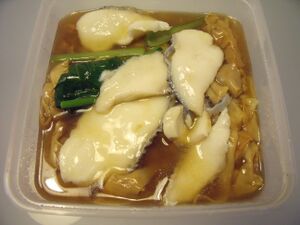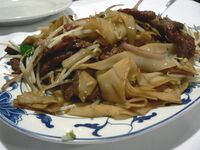شاهى فن
| ملف:Ho fan in noodles shop.jpg Boxes of shahe fen | |
| أسماء بديلة | Ho fun, hofoen, hor fun, sar hor fun, kway teow, guotiao, da fen, guay tiew sen yai, kwetiau |
|---|---|
| النوع | Chinese noodles |
| مكان الأصل | China |
| المنطقة أو الإقليم | Shahe District |
| المكونات الرئيسية | Rice |
| التنويعات | Kuyteav, hủ tiếu, kyay oh |
| |
| شاهى فن | |||||||||||||||||||
|---|---|---|---|---|---|---|---|---|---|---|---|---|---|---|---|---|---|---|---|
| الصينية | 沙河粉 | ||||||||||||||||||
| |||||||||||||||||||
| hefen | |||||||||||||||||||
| الصينية | 河粉 | ||||||||||||||||||
| |||||||||||||||||||
Shahe fen (沙河粉), or simply he fen (河粉), is a type of wide Chinese noodle made from rice.[1][2] Its Minnan Chinese name, 粿條 (pronounced guǒtiáo in Mandarin), is adapted into alternate names which are widely encountered in Southeast Asia, such as kway teow, kwetiau, and kuetiau; Thai: ก๋วยเตี๋ยว (kuaitiao). Shahe fen is often stir-fried with meat and/or vegetables in a dish called chao fen (炒粉; pinyin: chǎo fěn). While chao fen is a transliteration of Mandarin, chow fun from Cantonese (see the main article at beef chow fun) is the name most often given to the dish in Chinese restaurants in North America.
. . . . . . . . . . . . . . . . . . . . . . . . . . . . . . . . . . . . . . . . . . . . . . . . . . . . . . . . . . . . . . . . . . . . . . . . . . . . . . . . . . . . . . . . . . . . . . . . . . . . . . . . . . . . . . . . . . . . . . . . . . . . . . . . . . . . . . . . . . . . . . . . . . . . . . . . . . . . . . . . . . . . . . . .
الاسم
بالصينية
While shahe fen and he fen are transliterations based on Mandarin, there are numerous other transliterations based on Cantonese, which include ho fun, hofoen (a Dutch transliteration in Suriname), hor fun, sar hor fun, etc. In addition, shahe fen is often synonymously called kway teow (粿條), literally "ricecake strips", transliteration based on Minnan Chinese, POJ: kóe-tiâu) or in Mandarin, guotiao (Mandarin pinyin: guǒtiáo), as in the name of a dish called char kway teow.
However, generally, Minnan people consider shahe fen and kway teow to be two distinct foods, and continue to make a distinction between shahe fen and guotiao/kway teow in their speech. Hor fun was developed by the Cantonese and is thin and tapered like strips of tape, with some porous areas that absorb the gravy, taste, and flavour of the broth or sauce that it is cooked in because it contains less starchy content, which has been stripped away during the production process. In contrast, guotiao/kuay teow is dense, and less absorbent and contains a higher level of starch and is more impermeable to absorbing flavours, and thus has to be soaked for a longer period of time in the dish preparation usually for a day or more, or is soaked in water first for a long time before it is fried as char kway teow. The taste, texture, flavour, ingredients, length, thickness, width, style, density are considered very different to many people in China and Asia more broadly, but often people from other regions are not be able to tell the difference immediately.
Guotiao/kway teow has a different origin from shahe fen , from Northeast instead of Central China, and is a modification of the guo/kway (rice cake) production process, and originated as the ancient preservation of rice as a starch-filled cake patty (of which Korean rice strips are yet another descendant, as it was brought as a recipe from China to Choseon dynasty when the Emperor of China during the Ming dynasty took the Korean princess as one of his concubines, and this recipe was gifted to the people of Choseon as a betrothal gift to the Korean people).[بحاجة لمصدر] In Hokkien (Fujian) of China, this version of guotiao/kway teow was then influenced by the Cantonese shahe fen from the neighboring province of Guangdong. Cantonese culture from the 17th century onwards was thought of as the dominant culture of civilization and culture, of wealth, excess, and sophistication, so the ancient guotiao/kway teow underwent modification to become similar to the standard Cantonese shahe fen/hor fun. However, these two versions (guotiao/kway teow vs. shahe fen/hor fun) were spread to Southeast Asia and the world differently, thus they are presented differently in different dishes. Though some restaurants will make a strong distinction, other, more casual Chinese restaurants may use the two interchangeably. Original ricecakes and its strips (i.e. authentic guotiao/kway teow) are stiff in texture, even after cooking, often making them less popular with modern consumers.
Another similar noodle is the mee tai mak (米苔目) which is like the hor fun and the bee hoon combined with Milanese pasta.
It is also known in Sabah as da fen (大粉), means "wide vermicelli", due to its similarity of colour and texture to rice vermicelli.
في اللغات الأخرى
These noodles are called kwetiau in Indonesia, kuaitiao or guay tiew (ก๋วยเตี๋ยว) sen yai (เส้นใหญ่, حرفياً 'large rice noodles') in Thailand, hsan-bya (ဆန်ပြား, حرفياً 'flat rice') or nan-bya (နန်းပြား, حرفياً 'flat filigree') in Myanmar, and hủ tiếu or pho in Vietnam.
الأصل
Shahe fen is believed to have originated in the town of Shahe (صينية: 沙河؛ پنين: Shāhé؛ Jyutping: Saa1 Ho4�), now part of the Tianhe District in the city of Guangzhou, in the southern Chinese province of Guangdong, whence their name derives. Shahe fen is a common component of southern Chinese cuisine, although similar noodles are also prepared and enjoyed in nearby Southeast Asian nations such as Cambodia, Vietnam, Thailand, Philippines, Malaysia, Indonesia and Singapore, all of which have sizeable Chinese populations.[بحاجة لمصدر]
الأنواع
Shahe fen noodles are white in color, broad, and somewhat slippery. Their texture is elastic and a bit chewy. They do not freeze or dry well and are thus generally (where available) purchased fresh, in strips or sheets that may be cut to the desired width. Where fresh noodles are not available, they may also be purchased packaged in dried form, in various widths.
Shahe fen noodles are very similar to Vietnamese bánh phở noodles, which are likely derived from their Chinese counterpart.[بحاجة لمصدر] Although the phở noodles used in soups may vary in width, wide phở noodles are also common in stir fried dishes. The popular Thai dishes phat si-io and drunken noodles are also made with similar noodles.[بحاجة لمصدر]
كواي تياو KWAY TEOW
هي مجموعة أطباق آسيوية قوامها الأساسي معجنات الأرز العريضة التي تشبه الفيتوتشيني الشهيرة ...
وهي غير المي هوون التي تشبه إنجل هير.
أشهرها في ماليزيا :
- تشار كواي تيو أو چار كيوو تيو Char kway Teaow ...
- كواي تياو بفواكه البحر kuey teow seafood ...
- كواي تياو بالدجاج kuey teow ayam
- كواي تياو باللحم kuey teow daging
- كواي تياو بالزنجبيل KWAY TEOW HALIA
- حساء كواي تياو kuey teow sup
- كواي تياو محمر kuey teow goreng
تشاو فن
Shahe fen is often stir-fried with meat and vegetables in a dish called chao fen (炒粉; pinyin: chǎo fěn; jyutping: caau2 fan2). While chao fen is a transliteration of Mandarin, chow fun, from Cantonese, is the name to which this dish is most often referred in Chinese restaurants in North America.
انظر أيضاً
معرض صور
| Shahe fen
]].
. . . . . . . . . . . . . . . . . . . . . . . . . . . . . . . . . . . . . . . . . . . . . . . . . . . . . . . . . . . . . . . . . . . . . . . . . . . . . . . . . . . . . . . . . . . . . . . . . . . . . . . . . . . . . . . . . . . . . . . . . . . . . . . . . . . . . . . . . . . . . . . . . . . . . . . . . . . . . . . . . . . . . . . .
المراجع
- ^ Green, A.; Legato, S.; Casella, C. (2012). Making Artisan Pasta: How to Make a World of Handmade Noodles, Stuffed Pasta, Dumplings, and More. Quarry Books. p. 22. ISBN 978-1-61058-195-0. Retrieved August 26, 2018.
- ^ Lim, T.K. (2013). Edible Medicinal And Non-Medicinal Plants: Volume 5, Fruits. Springer Science & Business Media. p. 304. ISBN 9789400756533. Retrieved August 4, 2022.
وصلات خارجية
 Media related to Shahe fen at Wikimedia Commons
Media related to Shahe fen at Wikimedia Commons
- Short description matches Wikidata
- Articles containing صينية-language text
- Articles with unsourced statements from June 2020
- مقالات تحتوي نصوصاً باللغة الصينية
- مقالات ذات عبارات بحاجة لمصادر
- Articles with hatnote templates targeting a nonexistent page
- Cantonese cuisine
- Chinese noodles
- Hong Kong cuisine
- Singaporean cuisine





